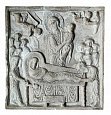Fragment of a triptych

The motifs in numerous representations of Mary’s death originate not from biblical but from apocryphal tradition. This is also the case here too. We can identify three moments. One’s view falls first on the death bed at the centre, where Mary is lying. It then rests on Christ, who stands behind his mother’s bed and holds her soul, which is depicted as a person deserting her body. Finally, it falls on two angels. One carries Mary’s soul into heaven. Death, escape of the soul and the way of the soul into heaven are thus united in one picture. The visible escape of the soul and it’s way into heaven (depicted as a person) might appear strange, offensive or disturbing to people in modern times, but it did not represent a problem to Christians for a long time. As in many such representations, here there is no doubt as to the origin and identity of the object. The representation comes from Byzantine artists and was probably made as the central part of a triptych. The ivory of the 10th century was inserted here into the cover of an Evangelistar, i. e. a liturgical book intended for public use. It has survived in its new context until now, and is housed at the Herzog-August-Library in Wolfenbuettel.




